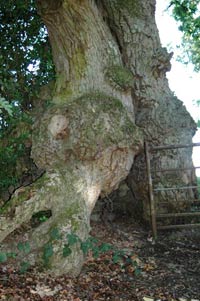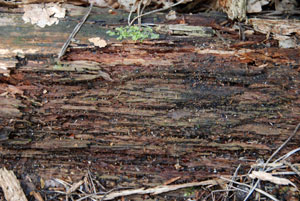Dead wood and stag beetles
Dead and decaying wood forms an important part of any tree or woodland. In the past, dead branches and trees in woodland might have been taken for a sign of neglect or a poorly managed wood; it was regarded as a possible source of disease or ‘rubbish’ that needed to be tidied away. However, dead wood, whether it is part of a living tree or lying on the woodland floor, should be regarded as a resource that contributes to the diversity of the flora and fauna. As wood decays, it offers a series of different microhabitats. It has been estimated that dead and decaying wood can offer a home to some 1800 species.
 Indeed the loss of veteran trees and dead wood is considered to be one of the major factors in the loss of biodiversity in woods and forests across Europe.
Indeed the loss of veteran trees and dead wood is considered to be one of the major factors in the loss of biodiversity in woods and forests across Europe.
http://www.wwf.org.uk/news/n_0000001373.asp
The process of decay and decomposition is largely due to fungi (accompanied by bacteria) and usually occurs from inside to out. Trees are colonised by fungi as they age; it is a step in the process of “veteranisation”. The eruption of fungal fruiting bodies from a tree is not a sure sign that it is about to die. The activity of the fungi creates hollows and cavities that reduce the weight of the tree; this may make it more stable. The process of heart rot means that the older wood or lignified tissue (no longer involved in water transport) is gradually broken down. White rotted heartwood offers food for insects like the rhinoceros and lesser stage beetle, whereas red rotted wood offers a meal for the hairy fungus beetle, amongst other invertebrates. Eventually, heartwood will produce a black wood mould that is home to some of the rarest invertebrates, such as the rusty click beetle.
http://www.woodland-trust.org.uk/ancient-tree-forum/atfecology/invertebrate.htm
 The stag beetle, our largest insect and a threatened species, spends its larval stage (which may last up to five years) feeding in rotting tree stumps. One way of encouraging stag beetles is to take logs between 10 and 50 cm in diameter [cut from Oak, Beech, Sycamore or Ash] and bury them vertically in the soil with their tops sticking out. They will slowly decompose, attracting insects and other invertebrates. This can be done in the garden as well as in woodland. The London Wildlife Trust has lots of information on stag beetles and if you can contribute to their survey, then visit this link:
The stag beetle, our largest insect and a threatened species, spends its larval stage (which may last up to five years) feeding in rotting tree stumps. One way of encouraging stag beetles is to take logs between 10 and 50 cm in diameter [cut from Oak, Beech, Sycamore or Ash] and bury them vertically in the soil with their tops sticking out. They will slowly decompose, attracting insects and other invertebrates. This can be done in the garden as well as in woodland. The London Wildlife Trust has lots of information on stag beetles and if you can contribute to their survey, then visit this link:
http://www.wildlondon.org.uk/stag_beetle.php
or for general information on improving the wildlife in your garden –
http://www.buglife.org.uk/html/gardens/wood-bugs.htm
UPDATE: you can contribute to the national survey of stag beetles on http://www.greatstaghunt.org !
Comments are closed for this post.
Discussion
[…] cities, we can help many animal species – such as sparrows, hedgehogs, thrushes, bumblebees and stag beetles. You can also help in the London Wildlife Trust’s garden wildlife survey and stag beetle […]
[…] – see how many creepy crawlies you can find in an old fallen tree […]

[…] – see how many creepy crawlies you can find in an old fallen tree […]
Half-term with Woodlands.co.uk | Woodlands.co.uk
20 April, 2018